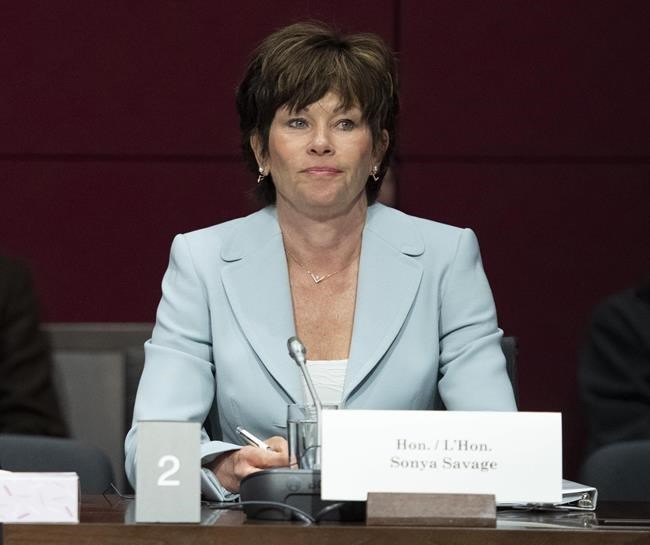Alberta didn't live up to the terms of a deal it has with the Northwest Territories to inform it about threats to its shared watershed after two major oilsands tailings spills, the territory's environment minister said Friday.
Shane Thompson said the lack of communication isn't encouraging as Alberta and the federal government work out the terms under which tailings will be treated and released into the Athabasca River.
"The bilateral agreement says Alberta is supposed to advise us with any ecological changes that happen and they didn't do that," he said.
"This event underlines our position. The government of the N.W.T. will not support the release of tailings unless rigorous science shows how to do it. We also need to see the science."
Employees at Imperial Oil's Kearl first reported seepage from a tailings pond last May to the Alberta Energy Regulator. A second release of at least 5.3 million litres of water was reported in early February from a storage pond.
The wastewater exceeds federal and provincial guidelines for iron, arsenic, sulphates and hydrocarbons that could include kerosene, creosote and diesel. The seepage, the amount of which hasn't been estimated, continues.
Thompson said his government was never officially notified about the spill, despite the 2015 legally binding Mackenzie Basin Bilateral Water Management agreement with Alberta. That agreement emphasizes several times the importance of mutual and prompt notification of changes on the watershed, including during an emergency.
"The protocols will ensure that the party within whose jurisdiction the emergency originates will, without delay, notify the other partner," it says.
Thompson said he met several times with his Alberta counterpart Sonya Savage after the leak was first reported and before Feb. 6, when the Alberta Energy Regulator issued an environmental protection order.
"At no point in time did that conversation come up," he said.
Federal Environment Minister Steven Guilbeault said he is deeply concerned about the reports about the Kearl mine tailings ponds.
He said his first thoughts are for the health and well-being of families in Athabasca Chipewyan First Nation and other affected communities.
"I have reached out to both Chief (Allan) Adam from the Athabasca Chipewyan First Nation as well as my counterpart in Alberta, Minister Sonya Savage, to get to the bottom of the situation from their perspectives and offer the unwavering support of the federal government," Guilbeault said in a statement.
Guilbeault said federal enforcement officers from his department will be given all the resources necessary to continue their independent assessment, under the jurisdiction of the federal Fisheries Act, to determine next steps.
"We need to see a clear remediation plan from the company and to better understand the apparent failures of communication for the notification of this spill," he said.
"Rebuilding a relationship based on trust will take a concerted effort, as well as transparency, collaboration and industry investment."
Savage said Alberta's United Conservative Party government is monitoring the situation and she and Premier Danielle Smith have been briefed by the province's regulator.
"We understand from them that remediation is underway, and no contaminated water has entered into the water system or affected human health or wildlife," Savage said in a release.
“The Government of Alberta is standing by to assist the Athabasca Chipewyan First Nation and other communities in any way necessary should it be required, and we look forward to the results of the AER investigation."
Neither government has indicated when they first learned of the leak.
This is not the first time the N.W.T. has expressed frustration with its upstream neighbour. In August 2020, the territory was unhappy about not being told Alberta had suspended environmental monitoring on the Athabasca due to COVID-19 concerns. Monitoring was later resumed and still continues.
Now, Thompson said the territory isn't playing a big enough role in developing regulations for the eventual release of treated oilsands tailings water into the river.
"We need the science that they're supposed to share with us," he said. "It has to be transparent.
"We've started the conversation, (but) we want it to be more on a regular basis."
Meanwhile, a second First Nation has complained about being poorly informed about the spills on lands they harvest from.
On Thursday, Chief Adam of the Athabasca Chipewyan First Nation said he only learned of the extent of the spill after the Alberta Energy Regulator issued the environmental protection order and accused Imperial of trying to cover it up.
Friday, the Mikisew Cree First Nation said it had been treated the same way.
Chief Billy-Joe Tuccaro said the failure to keep his band posted is a failure by the Alberta Energy Regulator. Scientists warned of the likelihood of seepage from the ground under the tailings pond when the project was first approved, he said.
"The AER and Canada approved Imperial’s project knowing the risk of seepage for this tailing pond. There needs to be an independent review of the approval of this tailings pond and the AER’s management of this mess," he said.
This report by The Canadian Press was first published March 3, 2023.
Bob Weber, The Canadian Press

